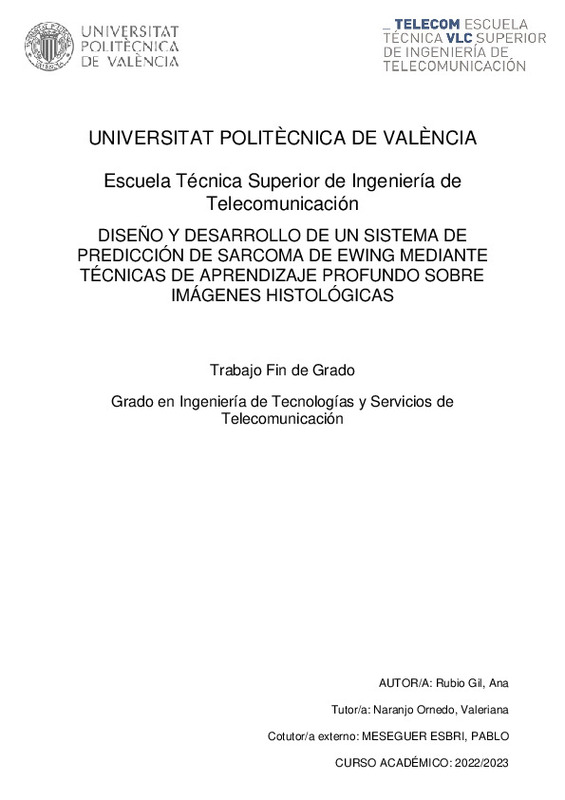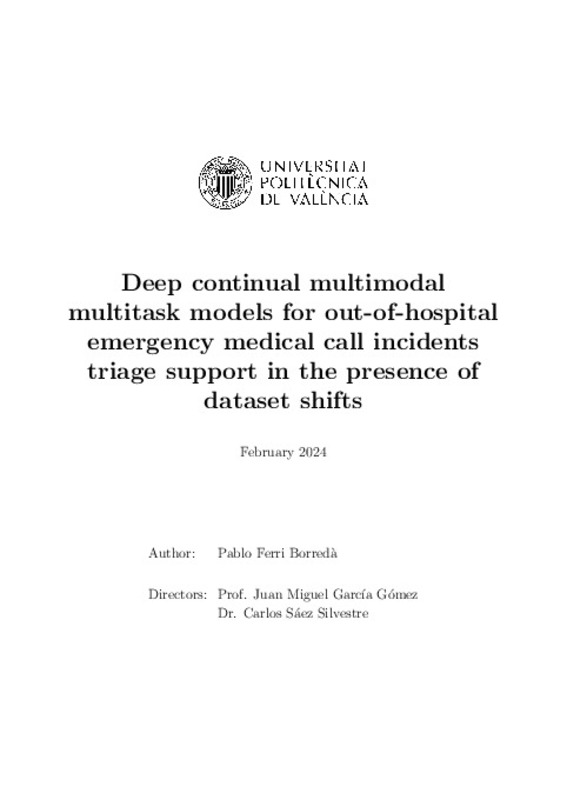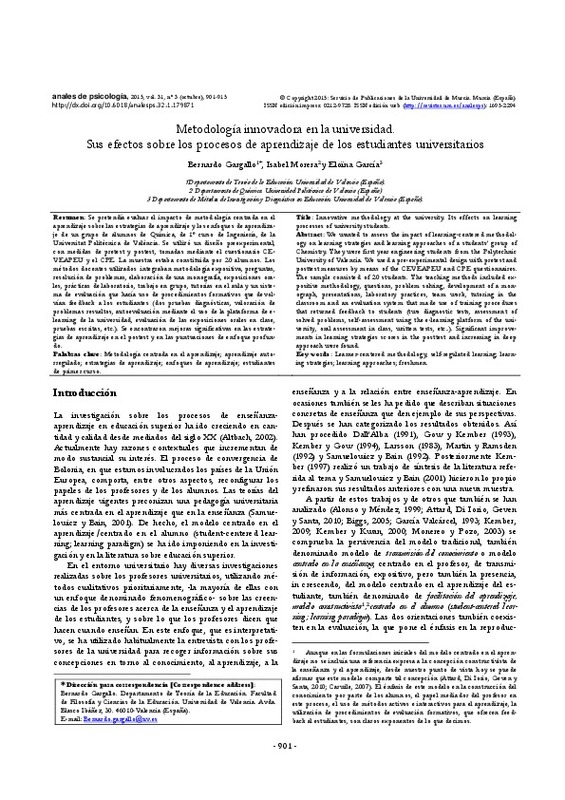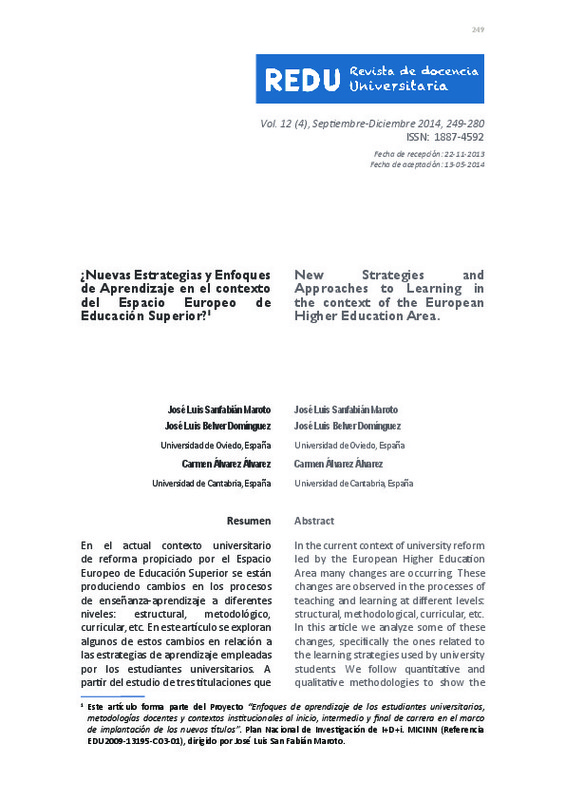JavaScript is disabled for your browser. Some features of this site may not work without it.
Buscar en RiuNet
Listar
Mi cuenta
Estadísticas
Ayuda RiuNet
Admin. UPV
DISEÑO Y DESARROLLO DE UN SISTEMA DE PREDICCIÓN DE SARCOMA DE EWING MEDIANTE TÉCNICAS DE APRENDIZAJE PROFUNDO SOBRE IMÁGENES HISTOLÓGICAS
Mostrar el registro sencillo del ítem
Ficheros en el ítem
| dc.contributor.advisor | Naranjo Ornedo, Valeriana
|
es_ES |
| dc.contributor.advisor | Meseguer Esbrí, Pablo
|
es_ES |
| dc.contributor.author | Rubio Gil, Ana
|
es_ES |
| dc.date.accessioned | 2023-07-26T15:00:06Z | |
| dc.date.available | 2023-07-26T15:00:06Z | |
| dc.date.created | 2023-07-25 | es_ES |
| dc.date.issued | 2023-07-26 | es_ES |
| dc.identifier.uri | http://hdl.handle.net/10251/195565 | |
| dc.description.abstract | [ES] El sarcoma de Ewing es un tipo de cáncer que se desarrolla en los huesos y en el tejido blando que los rodea. Aunque la incidencia es baja a nivel global, en niños y adolescentes es uno de los tumores más frecuentes y agresivos, lo que genera un gran impacto social y representa un desafío para encontrar un diagnóstico y tratamiento óptimo ya que la tasa de supervivencia está altamente relacionada con la cantidad de propagación del tumor. En la actualidad, se diagnostica mediante biopsias y su análisis histológico, aunque solamente con esto es difícil diferenciar entre sarcomas de Ewing y otro tipo de tumores de células redondas y pequeñas. Esto es un problema debido a que el tratamiento y pronóstico para cada uno de los diferentes tumores es distinto. Para la implementación de sistemas de ayuda basados en computador que asistan a los médicos en la toma de decisiones, se emplean escáneres de patología digital para la digitalización de las biopsias. En este proyecto se pretende desarrollar un sistema de clasificación basado en aprendizaje profundo sobre imágenes de histología digitalizadas. Estos tipos de algoritmos son capaces de analizar grandes cantidades de datos y aprender patrones para realizar tareas que pueden llegar a imitar las capacidades humanas. Los métodos explorados se basan en redes neuronales convolucionales que están compuestas por distintas capas interconectadas entre sí para extraer características de las imágenes. El sistema diseñado será capaz de clasificar imágenes de sarcoma de Ewing y otros tipos de tumor de células redondas y pequeñas. Exploraremos distintos algoritmos de aprendizaje que se adaptan a la naturaleza de los datos para ver cuál ofrece mejores resultados, como son el supervisado y el débilmente supervisado, concretamente el de múltiples instancias. | es_ES |
| dc.description.abstract | [EN] Ewing sarcoma is a type of cancer that develops in the bones and the soft tissue surrounding them. Although the global incidence is low, in children and adolescents, it is one of the most frequent and aggressive tumors, which generates a significant social impact and represents a challenge to find an optimal diagnosis and treatment, as the survival rate is highly related to the tumor¿s extent of spread. Currently, it is diagnosed through biopsies and histological analysis, although it is difficult to differentiate between Ewing sarcoma and other types of small round cell tumors with only these methods. This is a problem because the treatment and prognosis differ for each tumor type. For the implementation of computer-aided diagnosis systems that assist doctors in decision-making, digital pathology scanners are used for the digitization of biopsies. This project aims to develop a classification system based on deep learning on digitized histology images. These types of algorithms can analyze large amounts of data and learning patterns to perform tasks that can mimic human capabilities. The explored methods are based on convolutional neural networks, which consist of interconnected layers to extract features from the images. The designed system will be able to classify images of Ewing sarcoma and other types of small round cell tumors. We will explore different learning algorithms that adapt to the nature of the data to determine which one offers better results, such as supervised learning and weakly supervised learning, specifically multiple-instance learning. | en_EN |
| dc.format.extent | 55 | es_ES |
| dc.language | Español | es_ES |
| dc.publisher | Universitat Politècnica de València | es_ES |
| dc.rights | Reserva de todos los derechos | es_ES |
| dc.subject | Sarcoma de Ewing | es_ES |
| dc.subject | Tumores de células redondas y pequeñas | es_ES |
| dc.subject | Imagen histológica | es_ES |
| dc.subject | Aprendizaje profundo | es_ES |
| dc.subject | Clasificación de imágenes | es_ES |
| dc.subject | Aprendizaje supervisado | es_ES |
| dc.subject | Aprendizaje débilmente supervisado | es_ES |
| dc.subject | Aprendizaje de múltiples instancias. | es_ES |
| dc.subject | Ewing sarcoma | en_EN |
| dc.subject | Small round cell tumors | en_EN |
| dc.subject | Deep learning | en_EN |
| dc.subject | Image classification | en_EN |
| dc.subject | Supervised learning | en_EN |
| dc.subject | Weakly supervised learning | en_EN |
| dc.subject | Multiple instance learning. | en_EN |
| dc.subject.classification | TEORÍA DE LA SEÑAL Y COMUNICACIONES | es_ES |
| dc.subject.other | Grado en Ingeniería de Tecnologías y Servicios de Telecomunicación-Grau en Enginyeria de Tecnologies i Serveis de Telecomunicació | es_ES |
| dc.title | DISEÑO Y DESARROLLO DE UN SISTEMA DE PREDICCIÓN DE SARCOMA DE EWING MEDIANTE TÉCNICAS DE APRENDIZAJE PROFUNDO SOBRE IMÁGENES HISTOLÓGICAS | es_ES |
| dc.title.alternative | DESIGN AND DEVELOPMENT OF AN EWING'S SARCOMA PREDICTION SYSTEM USING DEEP LEARNING TECHNIQUES ON HISTOLOGICAL IMAGES | es_ES |
| dc.title.alternative | DISSENY I DESENVOLUPAMENT D'UN SISTEMA DE PREDICCIÓ DE SARCOMA D'EWING MITJANÇANT TÈCNIQUES D'APRENENTATGE PROFUND SOBRE IMATGES HISTOLÒGIQUES | es_ES |
| dc.type | Proyecto/Trabajo fin de carrera/grado | es_ES |
| dc.rights.accessRights | Abierto | es_ES |
| dc.contributor.affiliation | Universitat Politècnica de València. Departamento de Comunicaciones - Departament de Comunicacions | es_ES |
| dc.contributor.affiliation | Universitat Politècnica de València. Escuela Técnica Superior de Ingenieros de Telecomunicación - Escola Tècnica Superior d'Enginyers de Telecomunicació | es_ES |
| dc.description.bibliographicCitation | Rubio Gil, A. (2023). DISEÑO Y DESARROLLO DE UN SISTEMA DE PREDICCIÓN DE SARCOMA DE EWING MEDIANTE TÉCNICAS DE APRENDIZAJE PROFUNDO SOBRE IMÁGENES HISTOLÓGICAS. Universitat Politècnica de València. http://hdl.handle.net/10251/195565 | es_ES |
| dc.description.accrualMethod | TFGM | es_ES |
| dc.relation.pasarela | TFGM\157940 | es_ES |
Este ítem aparece en la(s) siguiente(s) colección(ones)
-
ETSIT - Trabajos académicos [2410]
Escuela Técnica Superior de Ingenieros de Telecomunicación









